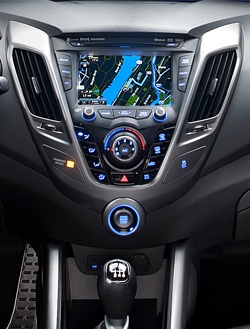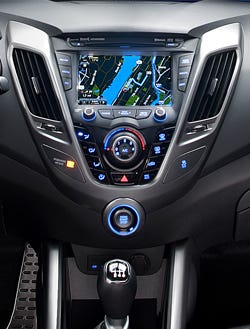Despite Progress, Hyundai Still Sees Room for Quality Improvement
"We've made a ton of progress," the auto maker’s U.S. director-product quality says. "But we have a long way to go. Until we start building cars that never have a problem for 10 years, I'm not going to be satisfied."


Few auto makers can claim a quality turnaround as quick as Hyundai’s.
Once a poster child for poor workmanship, the Korean brand now is at or near the top of many third-party quality surveys in the U.S., and internal data shows progress as well.

'12 Veloster sport coupe’s center-stack switchgear tweaked.
"Overall, I think we're doing really well," says Erwin Raphael, director-product quality and service engineering for Hyundai Motor America. "I'm more intrigued with the rate at which we're improving. I'm happy with where we are. We can put our cars against anybody in the industry."
But because his job is to be critical, Raphael says he won't be happy until long-term reliability is achieved.
"We've made a ton of progress," he tells WardsAuto in an interview. "But we have a long way to go. Until we start building cars that never have a problem for 10 years, I'm not going to be satisfied."
That said, Raphael, a nearly 20-year veteran of the auto industry who came to Hyundai 18 months ago from Chrysler, is pleased with what the Korean auto maker has achieved in other quality measures.
One of Raphael's final duties at Chrysler was playing an integral role in the auto maker’s interiors for the '11 model year. He says Hyundai's interiors are an area where the Korean auto maker is doing most everything right. "We've made a lot of progress, even in the last two years."
Many auto makers initially were headed in the opposite direction due to value engineering, he adds. But they learned that taking $100 cost out of materials gave customers the impression the car was worth thousands less than competing models.
Hyundai's performance quality also is good, Raphael believes. This includes all aspects of the driving experience, from ride-and-handling, steering, transmission and throttle calibration to the feel of the radio control knobs.
Raphael also is responsible for the fine-tuning of Hyundai vehicles engineered overseas, such as the new '12 Veloster sport coupe. Among the few things engineers here tweaked was the center-stack switchgear.
For example, the font on the airflow-direction buttons lacked contrast, making it difficult for customers to see where the arrows were pointing. “So we made that clearer," he says. The heating, ventilation and air-conditioning knob was made bigger to meet U.S. customers’ tastes.
"Customers have told us indirectly from many different forums that they like big, easy-to-grab knobs that are not distracting," he says. "They hate the 50 buttons you see on some competitive cars and have to figure out which ones (do what)."
Hyundai tries to engineer vehicles right the first time, Raphael says. The auto maker maintains a customer-feedback data base to help it maker make future refinements.
Raphael, who also oversees warranty policy, dealer-technician training and port operations for Hyundai, describes the corporate culture at the company as "very, very different" from Chrysler, as well as another former employer, Toyota.
"One thing Hyundai does very well is reacting quickly and getting things done quickly," he says of rolling changes often made to fully formed models. And it’s not unusual for negative customer and media feedback on disliked features to be sent immediately to engineers in Korea.
"Tonight, morning their time, I'll have engineers in another part of the world coming up with options," Raphael says. Despite the sometimes challenging cultural differences between Korean and American employees, "everybody wants the same thing.”
About the Author
You May Also Like





